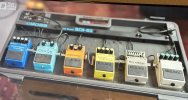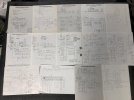weird guitar person
Experienced
Built a lot of rigs over the years, imitating my heroes and heroines naively in the absence of the knowledge that we take for granted online these days.
Kind of a shame, as I was 90% of the way there on many of the rigs I put together. Some of the features in my nineties era multi-effect rack units make perfect sense now that I know what came before.
Recently I’ve been super stoked about 80’s session players’ rigs for which schematics are readily available online. (Ironically, I think session players make good models for managing complexity and keeping things simple and reliable!)
Here’s an example routing that I’d not considered on my own that’s blown my mind…
Heavy feed-forward compression into eq to restore brightness, into tri-chorus, split into harmonizer stereo de-tune and stereo reverb in parallel, mixed together into dual delay units, with dry signal maintained all the way through.
Anyone else have favorite non-standard (by today’s standard common practice?) routings and or effect ordering tips they’re excited about? Hope so!
Cheers all, Daniel
Kind of a shame, as I was 90% of the way there on many of the rigs I put together. Some of the features in my nineties era multi-effect rack units make perfect sense now that I know what came before.
Recently I’ve been super stoked about 80’s session players’ rigs for which schematics are readily available online. (Ironically, I think session players make good models for managing complexity and keeping things simple and reliable!)
Here’s an example routing that I’d not considered on my own that’s blown my mind…
Heavy feed-forward compression into eq to restore brightness, into tri-chorus, split into harmonizer stereo de-tune and stereo reverb in parallel, mixed together into dual delay units, with dry signal maintained all the way through.
Anyone else have favorite non-standard (by today’s standard common practice?) routings and or effect ordering tips they’re excited about? Hope so!
Cheers all, Daniel


